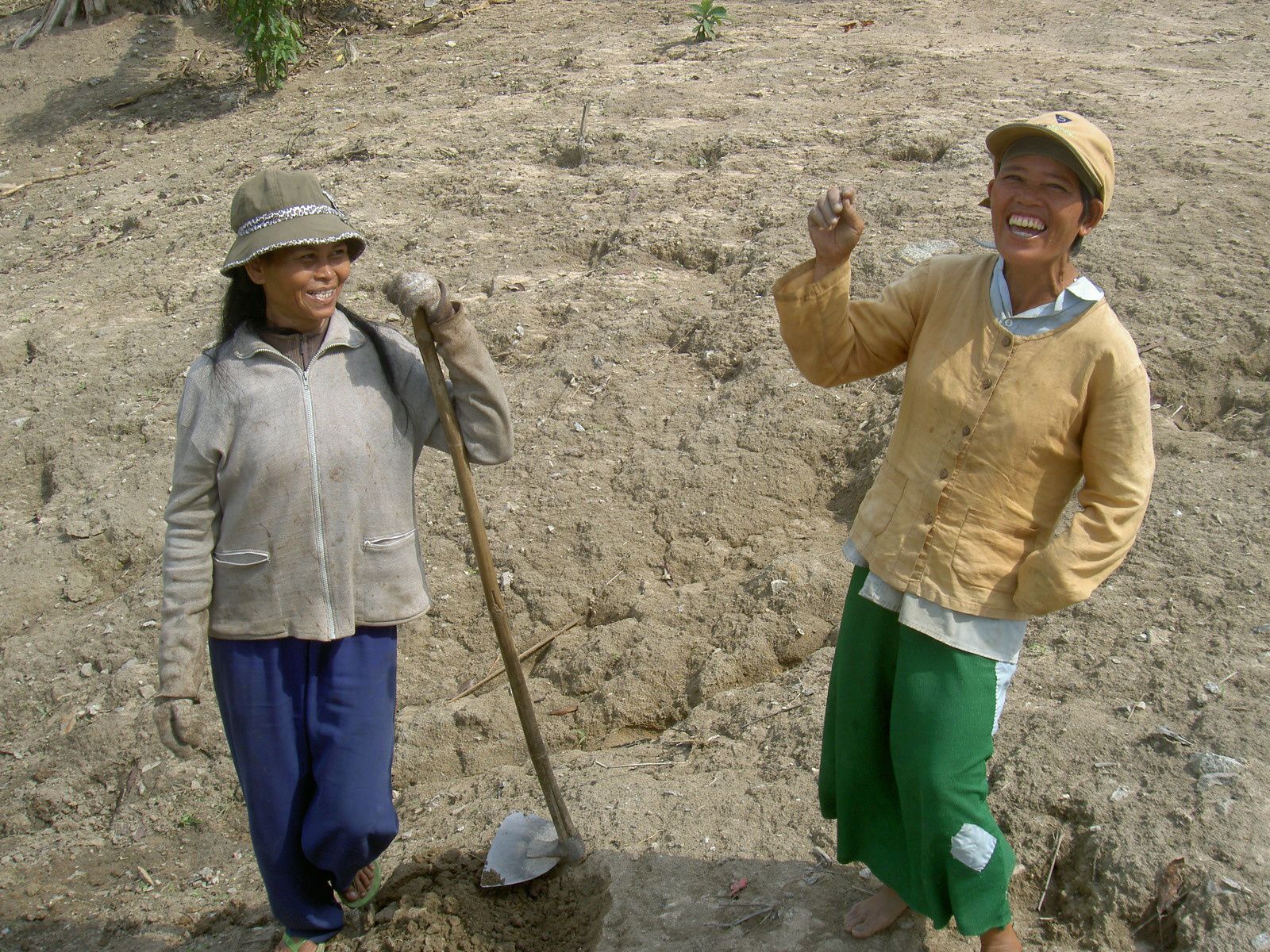Peut-on dire que l'on devient expert dans l'art d'aimer en venant faire un séjour plus ou moins long au mouvement des Focolari? Je pense que ce serait présomptueux pour plusieurs raisons. D'abord parce qu'il ne faut pas attendre de connaître ce mouvement pour commencer à aimer. Jésus et l'Évangile sont clairs sur l’exigence, le commandement de l’amour. Si nous entrons dans un séminaire pour devenir des personnes consacrées, c'est parce que nous avons déjà fait l'expérience de l'amour et que nous découvrons dans notre cœur une grande générosité qui nous pousse à aimer toutes les personnes sans distinction. Deuxièmement, plus nous restons dans un groupe, plus nous nous rendons compte que dans n'importe quel groupe, décider d'aimer ne signifie pas toujours réussir à aimer. Les douze apôtres, bien qu'ils aient vécu avec celui qui était le plus à même de leur enseigner ce qu’est l’amour véritable, voulaient être considérés comme des personnes importantes. Ils étaient tentés par l'orgueil, alors que Jésus leur avait dit que ce qui compte, c'est d'être le plus humble de tous et le serviteur de tous. Si je devais comparer la manière dont nous aimons dans ma congrégation et la manière dont les personnes s’aiment dans le mouvement des Focolari, je pourrais certainement expliquer pourquoi, par certains aspects de notre vie, nous aimons mieux dans ma congrégation que chez les Focolari et pourquoi, par d'autres aspects, les Focolari aiment davantage. Mais il ne sert à rien de comparer. Ce qui compte, c'est d'apprendre de chaque lieu où nous vivons ce que nous pouvons tirer des personnes que nous rencontrons. Pour les futurs prêtres que vous êtes, c'est essentiel. Appelés à être pasteurs, vous êtes constamment invités par Dieu à connaître les gens, à voir ce qui les fait vivre et à les encourager à persévérer dans leur spiritualité et leurs engagements. Pour vous comporter de la sorte, vous ne pouvez pas rester à distance. Il vous faut proche d’eux, de ce qu'ils vivent. Pour moi, être pasteur, c'est être joyeux et enthousiaste vis-à-vis des gens que nous rencontrons, leur dire que ce qu’ils font est positif et que nous les soutenons.
Cela dit, qu'est-ce que les Focolari m'ont appris depuis mon enfance et surtout cette année à Tagaytay ? Durant ces quelques mois, j’ai pu approfondir un point clé de la spiritualité des Focolari, à savoir l'identification de la relation qui existe entre l'expérience de Jésus abandonné sur la croix (lorsqu'il exprime à Dieu le Père son sentiment total de solitude) et l'amour qu'à ce moment précis, il offre à tous les hommes. Pour Jésus comme pour nous, aimer dans les moments de souffrance et de solitude n'est pas moins fructueux qu'aimer quand on sent que les gens nous aiment en retour et qu'il y a un amour réciproque. Il est mystérieux et très difficile d'accepter ce mystérieux "amour souffrant". Cependant, c'est une chose étonnante à méditer avec soin dans nos vies. En fait, chaque fois que nous faisons l'expérience de l'échec de l'amour mutuel, nous pouvons encore aimer les autres et même les aimer davantage, avec la grâce de Dieu. Je ne suis pas sûr d'avoir bien compris (ou mis en pratique !) ce que je suis en train de vous dire, mais à vrai dire, bien souvent, quand je suis dans un moment de détresse, je dis à Dieu : "Aide-moi à aimer mes ennemis" et le fait de me sentir uni à Jésus sur la croix à ce moment précis où je suis méprisé par les autres, m'aide à accepter les choses avec humilité et avec amour. Une autre chose que j'ai apprise cette année et qui m'a profondément touchée, c’est la définition de la chasteté donnée par Chiara Lubich, la fondatrice du mouvement des Focolari. La chasteté est liée à un autre point clé de la spiritualité des Focolari, l'appel à vivre le moment présent, sans se laisser distraire ni par le passé ni par l'avenir. Selon Chiara Lubich, être chaste, c'est être pleinement présent à la personne que l'on a en face de soi à l’instant T, et après avoir pris congé de cette personne, parce que l’on poursuit ses activités quotidiennes, avoir exactement la même attitude avec la personne suivante, en mettant de côté la personne précédente, afin d'être pleinement présent à cette dernière. En faisant cela, nous vivons pleinement notre appel surnaturel à vivre uniquement pour Jésus et nous vivons également de belles relations avec les gens qui touchés par la qualité de notre relation avec eux.
le père Jay, l'équipe paroissiale et l'Eglise de Moonwalk où j'ai célébré à de nombreuses reprises.
Le troisième élément des Focolari qui me soutient aussi dans ma vie est l'art de partager les expériences sur la façon d'aimer. Ce n'est pas que je réussisse à aimer à chaque instant de ma vie, mais je suis prêt à partager ce que je vis à d'autres personnes, afin qu'elles puissent ou se sentir encouragées lorsque j'ai réussi à aimer avec générosité mes frères et sœurs, ou porter ma croix et prier pour moi lorsque je n'ai pas réussi à aimer mes frères et sœurs. Ai-je pratiqué ces trois éléments de la spiritualité ici ? Oui, je l'ai fait : je me suis senti parfois abandonné, j'ai essayé de vivre pour la personne en face de moi, j'ai partagé mon expérience à de nombreuses reprises et j'ai écouté les expériences d'autres personnes. Ai-je réussi ? Pas toujours... mais je veux continuer à développer cet art d'aimer, merci pour votre attention.




/image%2F1456533%2F20240421%2Fob_c44964_1-fr.jpeg)
/image%2F1456533%2F20240421%2Fob_2dde5b_2-fr.jpg)
/image%2F1456533%2F20240421%2Fob_c4fb84_3-fr.jpeg)
/image%2F1456533%2F20240421%2Fob_4a2c86_4-fr.jpg)
/image%2F1456533%2F20240421%2Fob_550a8b_5-fr.jpeg)
/image%2F1456533%2F20240421%2Fob_d8c19d_6-fr.jpeg)
/image%2F1456533%2F20240421%2Fob_a42207_7-fr.jpg)
/image%2F1456533%2F20240421%2Fob_e0cd2d_8-fr.jpg)


/image%2F1456533%2F20240421%2Fob_8ff300_1-eng.jpeg)
/image%2F1456533%2F20240421%2Fob_28f52c_2-eng.jpeg)
/image%2F1456533%2F20240421%2Fob_712259_3-eng.jpeg)
/image%2F1456533%2F20240421%2Fob_f899ce_4-eng.jpg)
/image%2F1456533%2F20240421%2Fob_56b71b_5-eng.jpg)
/image%2F1456533%2F20240421%2Fob_79a372_6-eng.jpg)
/image%2F1456533%2F20240421%2Fob_dfd8bf_7-eng.jpg)
/image%2F1456533%2F20240420%2Fob_b38b3b_1-fr.jpg)
/image%2F1456533%2F20240420%2Fob_5eaeb2_2-fr.jpg)
/image%2F1456533%2F20240420%2Fob_836d4d_3-fr-a.jpg)
/image%2F1456533%2F20240420%2Fob_1433dd_4-fr.jpg)
/image%2F1456533%2F20240420%2Fob_95dc7e_5-fr.jpg)
/image%2F1456533%2F20240420%2Fob_5945b5_6-fr.jpg)
/image%2F1456533%2F20240420%2Fob_8c7875_1-en.jpg)
/image%2F1456533%2F20240420%2Fob_d249ce_2-en.jpg)
/image%2F1456533%2F20240420%2Fob_ec4466_3-en-a.jpg)
/image%2F1456533%2F20240420%2Fob_abef7c_3-en.jpg)
/image%2F1456533%2F20240420%2Fob_8cbef9_5-en.jpg)
/image%2F1456533%2F20240420%2Fob_1d72f8_6-en.jpg)
/image%2F1456533%2F20231120%2Fob_d4ac83_2fr.jpg)
/image%2F1456533%2F20231120%2Fob_de16c7_3fr.jpg)
/image%2F1456533%2F20231120%2Fob_06a3cc_4fr.jpg)
/image%2F1456533%2F20231120%2Fob_a1a0bd_5fr.jpg)
/image%2F1456533%2F20231120%2Fob_5845f7_6fr.jpg)
/image%2F1456533%2F20231120%2Fob_0eec26_7fr.jpg)
/image%2F1456533%2F20231120%2Fob_273d8d_8fr.jpg)
/image%2F1456533%2F20231120%2Fob_aa0b73_9fr.jpg)
/image%2F1456533%2F20230920%2Fob_ba2a6d_1eng.jpg)
/image%2F1456533%2F20230920%2Fob_7bc912_2eng.jpg)
/image%2F1456533%2F20230920%2Fob_1f5897_4eng.jpg)
/image%2F1456533%2F20230920%2Fob_285b0b_5eng.jpg)
/image%2F1456533%2F20230920%2Fob_0be98c_6eng.jpg)
/image%2F1456533%2F20230920%2Fob_4548b3_7eng.jpg)
/image%2F1456533%2F20230920%2Fob_ebeba1_8eng.jpg)
/image%2F1456533%2F20230829%2Fob_54a24a_2fr.jpg)
/image%2F1456533%2F20230829%2Fob_37d7d9_3fr.jpg)
/image%2F1456533%2F20230829%2Fob_af4328_4fr.jpg)
/image%2F1456533%2F20230829%2Fob_63b706_1fr.jpg)
/image%2F1456533%2F20230829%2Fob_ea696a_5fr.jpg)
/image%2F1456533%2F20230829%2Fob_13e46b_6fr.jpg)
/image%2F1456533%2F20230829%2Fob_7360e6_7fr.jpg)
/image%2F1456533%2F20230829%2Fob_bcd6a9_8fr.jpg)
/image%2F1456533%2F20230829%2Fob_87119b_9fr.jpg)
/image%2F1456533%2F20230829%2Fob_11fb1f_10fr.jpg)
/image%2F1456533%2F20230829%2Fob_3d46b5_11fr.jpg)
/image%2F1456533%2F20230829%2Fob_f501f9_1eng.jpg)
/image%2F1456533%2F20230829%2Fob_4d3399_2eng.jpg)
/image%2F1456533%2F20230829%2Fob_0a42e7_3eng.jpg)
/image%2F1456533%2F20230829%2Fob_e1fed1_4eng.jpg)
/image%2F1456533%2F20230829%2Fob_4a5bf9_5eng.jpg)
/image%2F1456533%2F20230829%2Fob_3c9597_6eng.jpg)
/image%2F1456533%2F20230829%2Fob_201528_7eng.jpg)
/image%2F1456533%2F20230829%2Fob_498ba0_8eng.jpg)
/image%2F1456533%2F20230829%2Fob_6dc21f_9eng.jpg)
/image%2F1456533%2F20230829%2Fob_0fbba3_10eng.jpg)
/image%2F1456533%2F20221225%2Fob_978a5d_img-20221212-wa0000.jpg)
/image%2F1456533%2F20221225%2Fob_5cf951_20221212-101431.jpg)
/image%2F1456533%2F20221225%2Fob_78acd2_img-20221215-wa0001.jpg)
/image%2F1456533%2F20221225%2Fob_f78c28_img-20221215-wa0016.jpg)
/image%2F1456533%2F20221225%2Fob_d109d5_img-20221208-wa0001.jpg)
/image%2F1456533%2F20221225%2Fob_6e389f_img-20221127-wa0005-copy.jpg)
/image%2F1456533%2F20221225%2Fob_40d2cc_img-20221121-wa0007.jpg)
/image%2F1456533%2F20221225%2Fob_5f91b2_img-20221121-wa0003.jpg)
/image%2F1456533%2F20221225%2Fob_cea05f_img-20221121-wa0019-copy.jpg)
